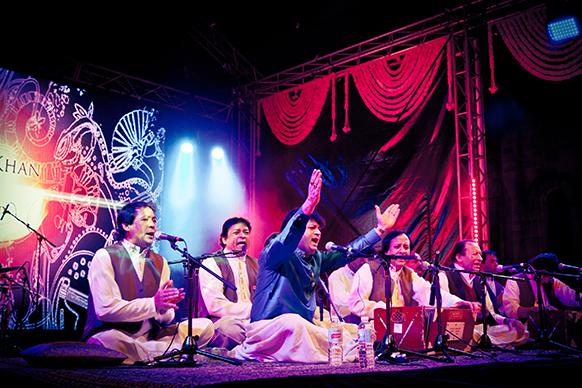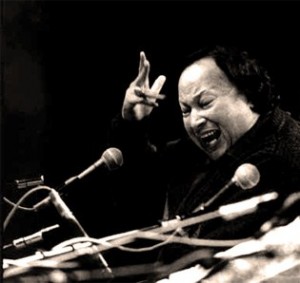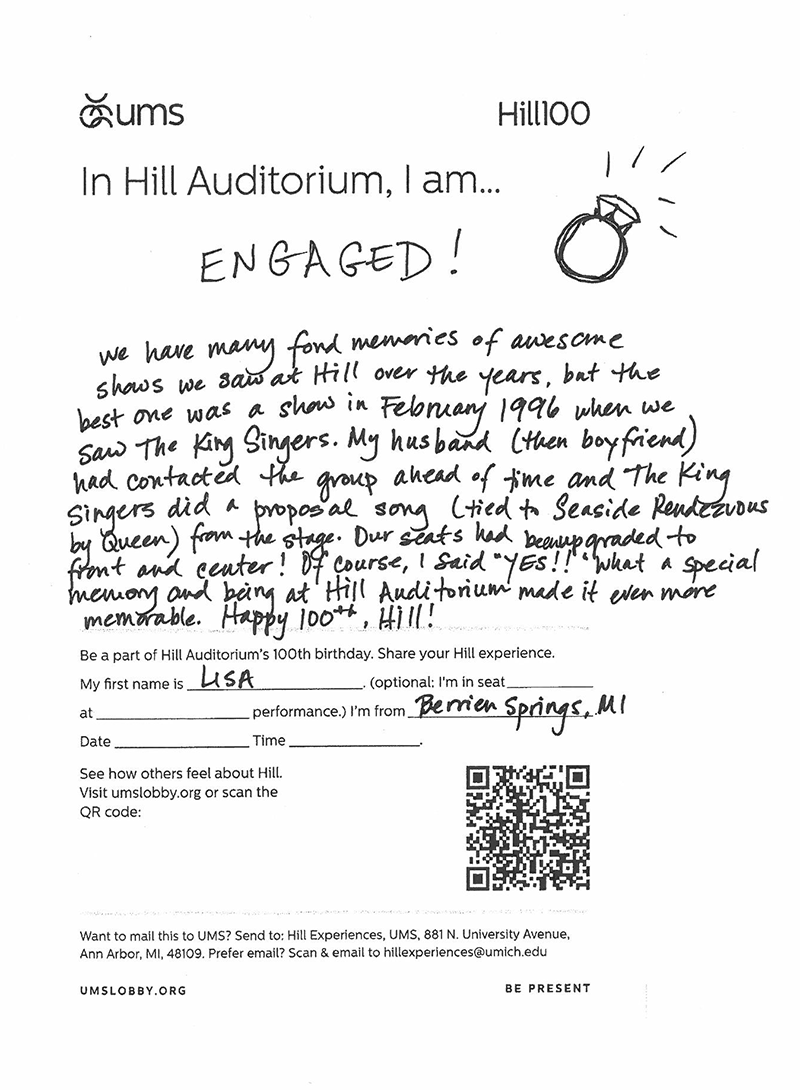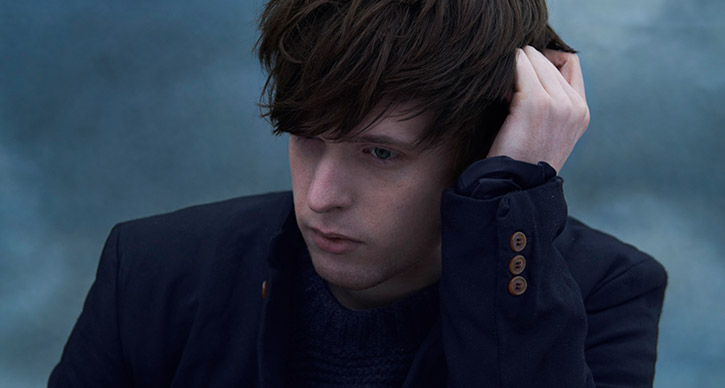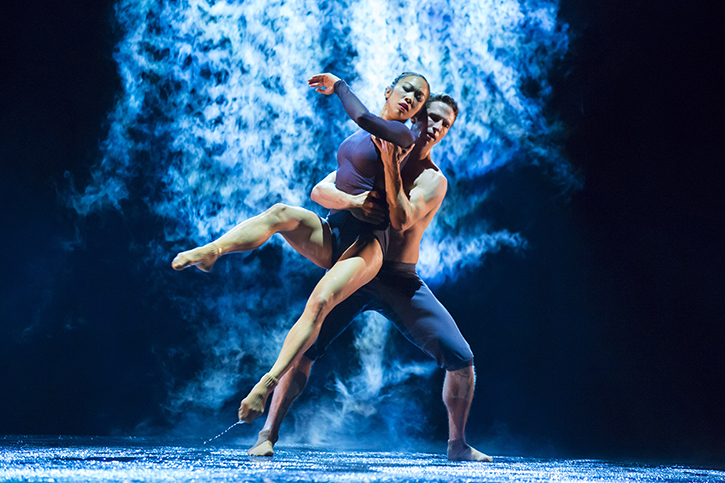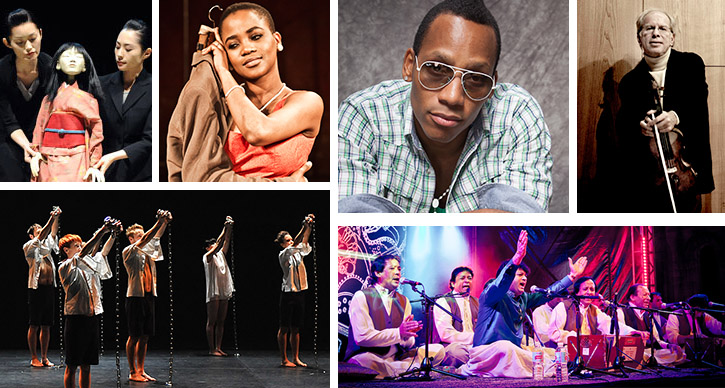UMS Playlist: Our 2014-2015 Season
This post is a part of a series of playlists curated by UMS staff, artists, and community. Check out more music here.
Now that we’ve announced our 2014-2015 season, it’s time to get more closely acquainted with its sounds. Listen along with our Spotify playlist featuring artists on our next season.
A [brief] UMS History Presentation: Bach Family Tree
So many Johanns, so little time. We can’t wait for the UMS presentation of Akademie für Alte Musik Berlin at Hill Auditorium on Sunday, April 13, 2014, and what better way to prepare for a Bach-themed concert than with a family tree of this gifted and musically enriched family.
Questions or comments? Leave them below.
A Closer Look at Qawwali: Interview with Farina Mir
Photo: Asif Ali Khan Qawaali Music of Pakistan performs.
On Friday, March 21, 2014 at 8 pm, UMS presents Asif Ali Khan Qawwali Music of Pakistan in Rackham Auditorium. A protege of the late, legendary Nusrat Fateh Ali Khan (1948-97), Asif Ali Khan performs the beautiful tradition of qawwali music of Pakistan and India. Whether you’re an adherent of the Sufi faith or not, the aesthetic experience of qawwali music is unique, inspiring, and inclusive.
To hear more, we talked with Farina Mir, the Associate Professor of History and Director of the Center for South Asian Studies at the University of Michigan. She is also the author of The Social Space of Language: Vernacular Culture in British Colonial Punjab (University of California, 2010), and co-editor of Punjab Reconsidered: History, Culture, and Practice (Oxford University Press, 2012).
Farina was fortunate enough to hear Nusrat Fateh Ali Khan perform, and the experience changed the professional focus of her life.
UMS: Tell us about your experience seeing Nusrat Fateh Ali Khan.
Farina Mir: I heard Nusrat Fateh Ali Khan at a charity dinner in New York City when I was only a junior in college. At the time, I hadn’t heard of the artist and was totally unfamiliar with the art of qawwali. I had only just started studying South Asian history; though, it quickly became a passion. I was particularly drawn to the history of the partition of India in 1947, which had led to the creation of Pakistan. This was a cataclysmic event, in which at least 17 million people migrated across newly created international borders (the largest peace time-migration of the twentieth century) and as many as one million people died in mass civil violence between members of different religious communities. I was particularly troubled by the violence of partition. The history I had learned—the standard history of the event at the time—found the roots of partition in “communalism,” antagonism along religious lines. It was a history that led one to think of Hindus and Sikhs, on the one hand, and Muslims on the other, as mutually antagonistic communities. What I saw at the charity concert undermined for me the certitude of this historical argument.
Many Voices
The audience for this concert wasn’t large; a relatively small hotel ballroom with people sitting at tables of 8 or 10, so maybe 200-300 people. Most of those in attendance were South Asian Muslims, but there was at least one table of Sikhs and Hindus. They stood out from the rest of the crowd because some of the men wore turbans and had unshorn beards. What stood out less than their presence—I knew from my own experience of growing up in the South Asian diaspora that members of all religious communities from the subcontinent intermingle socially—was their repeated requests for Nusrat Fateh Ali Khan to sing the compositions of particular Sufi poets. Qawwali as a genre is Sufi mystical poetry set to music. How were non-Muslims so familiar with Muslim Sufi poets, I wondered? And not only were they familiar with the poets’ names, but with particular compositions. They were making requests by reciting lines of Punjabi verse. And when Nusrat acknowledged their requests, I was struck by the looks of rapture of everyone around me, Hindu, Muslim, and Sikh alike.
An Enlightening Discovery
I, too, was taken in by the performance, by the pure pleasure of it—Nusrat Fateh Ali Khan and the qawwali form are nothing if not immensely powerful and emotive. But I was also taken in by the context of the performance. It produced a dissonance for me. I was struck by how the history books I was reading all emphasized Hindu, Sikh, and Muslim difference, yet what I saw that evening was a shared experience that defied the expectations produced by those history books. I began to wonder if there were historical antecedents to what I experienced that night. This led me to consider the historical role of the Punjabi language and its literary texts, including those of Sufi poets I heard at that performance, as the site for shared experiences among Hindus, Muslims, and Sikhs. What was hinted at in my experience that evening—the meaning, power, and pleasure of texts shared by members of different religious communities—led me to pursue a PhD in South Asian history, and today I teach in the history department at U-M. My book, The Social Space of Language: Vernacular Culture in British Colonial Punjab, provides one set of answers to the questions that emerged for me that night, with and through Nusrat Fateh Ali Khan’s amazing performance.
UMS: What do you think audience members who aren’t of the Sufi faith or no little about Sufi music will get out of the performance?
FM: As my comments above have suggested, there is undoubtedly an aesthetic beauty and emotional power to qawwali as an art form. It’s a pleasure to experience, no matter what one’s religion, or if one has no religious disposition at all. For those who know that this is a form of music associated with Sufi devotionalism, I think it will expose them to an aspect of Islam and Muslim devotion that has played a very significant role in Muslim devotion in the subcontinent historically, and continues to do so to this day.
UMS: What do you think people should look out for in seeing Asif Ali Khan’s performance with UMS this season?
FM: One of the pleasures of live performances of qawwali (as with other genres of Indian vocal performance) is artist improvisation. The genre lends itself to vocal improvisation, all within the bounds of a rigorous tradition of ragas and beat. Although improvisation is caught on recordings of live performance, the ability to see it in creation, as a response to a given environment is something you just can’t get off a CD!
UMS: Can you suggest some musical selections from Nusrat Fateh Ali Khan that might give our readers an entry point into his music? What’s important to you or interesting about these selections?
This is a hard question because there are so many dimensions to Nusrat Fateh Ali Khan’s music. One, of course, is that of aesthetic pleasure; the joy of the music/composition. This is accessible to anyone. The other, is the content of the verses set to music. Nusrat performed compositions in Persian, Urdu, and Punjabi (among other languages). Each has an important place in his repertoire. Three stand out for me, one in each language:
Qawwali in Farsi by Hazrat Amir Khusro in Raga Khamaj. I am not fluent in Persian, so can’t speak to the content of the poetry being performed in this composition, but what I love about this qawwali is how it ties contemporary practice, in time and space, to the subcontinent and the reputed creator of the art form of qawwali. Amir Khusro is a thirteenth century poet who was a devotee of the Sufi saint Nizamuddin Auliya. Amir Khusro is buried in the shrine complex that emerged around the tomb of Nizamuddin Auliya in Delhi, and one can today visit his tomb, the shrine of his patron and Sufi master, and hear qawwali—usually poems in praise of the Sufi saint—in the precincts of his shrine. Khusro was a Sufi adept, as well as a gifted poet and music theorist. He is considered the father of Hindustani classical music, and it is through his own devotional practice that qawwali as a genre was born.
Main Jana Jogi de Naal. This is a Punjabi qawwali that draws on the poetry of the Sufi saint Bulleh Shah. The text is a Sufi poem that points to the hypocrisy of empty ritual, pointing to love (for the divine) as true faith. It’s an immensely evocative poem in its language and its allusions, and is performed with a level of emotion that conveys the conviction of the text, even if you aren’t a Punjabi speaker!
Modern qawwali by Allama Iqbal in Raga Bilawal. Allama Iqbal (Muhammad Iqbal) is among the most renowned Urdu poets of the twentieth century. This qawwali takes one his most famous poems, Shikwa (Complaint), and performs it in the genre of qawwali. Iqbal’s poem is a political tract about the place and status of Muslims in the early twentieth century, rendered as a complaint to God. It is a brilliant poem that captures an important moment in South Asian history. I like this qawwali not only for its beautiful verse, but for the ways it exemplifies how flexible and adaptable the qawwali genre is, particularly in the hands of someone as talented as Nusrat Fateh Ali Khan.
Did you listen to Farina’s music selections? Were you familiar with qawwali before? What do you think?
UMS brings Asif Ali Khan to Ann Arbor in conjunction with UMMA’s exhibition of Doris Duke’s Shangri La: Architecture, Landscape, and Islamic Art on view January 25 – May 4, 2014. Learn more about the exhibition.
Take Our Quiz: Which UMS Performance is the Right Valentine’s Date for You?
Each year, UMS brings over 60 world-class performances to the Ann Arbor area. This year we’re lucky to have a diverse set of offerings right around Valentine’s Day weekend. How will you pick the right performance for you and your date? A handy quiz:
You never know what’ll happen. We received this Hill Auditorium memory last season:
Got a story about a date during a performance? Share it in the comments below.
5 Curiosities about Bullet Catch
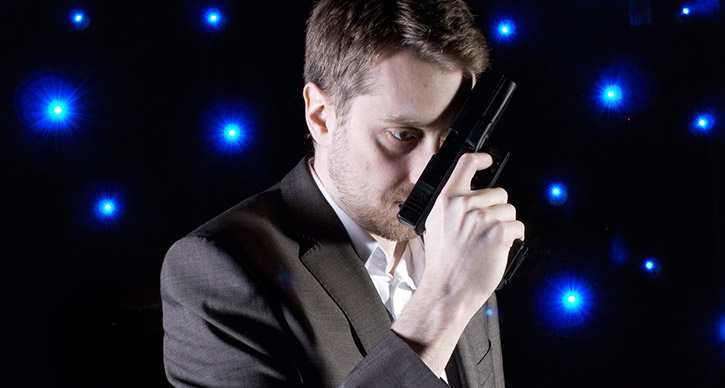
Photo: Rob Drummond in Bullet Catch. Photo courtesy of the artist.
A stunt so dangerous that Houdini refused even to attempt it, the magic trick known as the Bullet Catch has claimed the lives of at least 12 illusionists, assistants, and spectators since its conception in 1613. Director Rub Drummond explores the history of the Bullet Catch, including the true story of William Henderson, who died in 1912 attempting the infamous trick. Bullet Catch is (at Arthur Miller Theatre January 7-12), and in preparation, we’ve dug up 5 curious facts about the trick.
A Fresh Perspective: John Bracey on James Blake

Photo: John Bracey.
John Bracey, Executive Director of the Michigan Council of Arts and Cultural Affairs, took some time to speak with me about the artist he’s most looking forward to seeing this UMS season: James Blake (who performs at the Michigan Theater on November 11, 2013).
How did you become interested in James Blake?
I find him interesting! He’s young and doing innovative, different things in his music that I find very interesting. I first heard him when he came on my Brian Eno Pandora station. And I liked what I heard. Then, later, I was listening to my Joni Mitchell station and all of a sudden, he popped up there. On that station, too, I heard his cover of Joni Mitchell’s “Case of You,” which I liked. And anyone who does a cover of a Joni Mitchell song must have courage at the very least, I thought, so I continued to listen to his stuff and really enjoyed the different, creative modes he was using in his music.
What about James Blake’s technique do you like the most?
That’s a complicated question. Like I said, I’m a big Brian Eno fan, big Robert Fripp fan from way back…I like traditional sounds as well though, but what I really enjoy is that melancholy folk kind of thing that artists are doing nowadays, like Joni Mitchell. There’s also some poetry in their music as well, which I really appreciate. Like, Leonard Cohen, I’m a big Leonard Cohen fan, huge Laurie Anderson fan…and James Blake seems to play around in all those borderlines of artists and their techniques that I truly enjoy and appreciate.
Some people believe James Blake only appeals to the young, hipster crowd. Do you agree?
Well, not only! I’m definitely not young or hipster. My granddaughter listens to him, so you’re probably right. But not only. And I don’t think he should limit himself by thinking he only appeals to the young, hipster crowd. He is already showing some evolution and growth, in tracks like “Overgrown,” and I hope he continues to invent and grow.
What do you think of established organizations like UMS supporting “emerging” or “popular” artists like James Blake?
I think it’s a great thing for an organization like UMS, which is a jewel in the state of Michigan in terms of the kinds of performance opportunities they allow the citizens of the state to have access to. Over the years, I have seen at UMS everything from Laurie Anderson and Keith Jarrett to the Whirling Dervishes of Damascus. Where else am I going to see that if I’m not living in LA or New York? It’s a huge service. I think it also shows strength in organizations when they’re willing to stick to their mission of bringing the highest quality of art that one can offer while also attending to trends in popular culture.
Some people view popular culture as threatening the classical music traditions. What do you think?
Honestly, I don’t pay a lot of attention to folks when I start hearing that classical music is dying. I don’t believe that. Classical musicians will continue to engage with audiences just as before, but in different ways as well. People will learn to love what’s there. It’ll expand their tastes. Arts organizations that continue to present both sides are thriving while staying true to their mission. It’s about access. They’re more and more not just performance venues, but even visual arts venues, and arts venues generally. You have to compete in that market, but providing access in different ways is really what their missions say they should be doing all along anyway. And I think you’re seeing it.
Are there any other UMS events that you’re looking forward to this season?
I look forward to UMS’s season period. And I don’t get to go to nearly enough of their offerings.
Thanks for taking the time to answer our questions, John!
Join John in attending the upcoming UMS presentation of James Blake on Monday, November 11th at 7:30 pm at the Michigan Theater. Tickets on sale now.
A [brief] UMS History Presentation: The Ukulele
Ukulele star Jake Shimabukuro returns to Hill Auditorium on November 16, 2016.
He last performed in an Ann Arbor in 2014, and we created this handy infographic about the history of the ukulele in the U.S.

Are you a ukulele admirer or ukulele player? Share your best ukulele stories in the comments below.
Last updated 04/29/2016.
Outside Looking In: Anne Grove on Hubbard Street Dance
Editor’s note: Hubbard Street Dance Chicago return to Ann Arbor on October 27, 2015.
This UMS 13-14 Season, Hubbard Street Dance Chicago will be bringing their first, evening-length piece to Ann Arbor’s Power Center September 27-28. To learn more about Hubbard Street behind the scenes, their new work, and Hubbard Street’s first resident choreographer, Alejandro Cerrudo, I sat down with UMS Artist Services Manager, Anne Grove, to talk about her experiences working as the company manager of Hubbard Street prior to coming to UMS.
This is the first time Hubbard Street has performed with UMS while you are working at UMS. What does it feel like to have Hubbard Street perform as part of the UMS season?
I’m really proud to see the company coming here, bringing Alejandro’s work, and I’m excited to see them! I don’t get to Chicago very often, so I’m really looking forward to having them here and to fulfill my old role a bit, working with them backstage.
What was your favorite or most memorable experience while working with Hubbard Street?
There were so many it’s hard to land on one! For one thing, it was amazing to see what ambassadors the Hubbard Street dancers are for the city of Chicago and for dance. I’ve had so many people come up to me and say after seeing a performance, “Oh I’ve never really liked dance” or “never been interested in it,” but because Hubbard offered such a variety within a single performance, it was a really great entry point into dance for a lot of people.
Personally, I really enjoyed the places I was able to travel to during my time as Company Manager. The events and receptions I attended, the people I was able to meet because I was a part of Hubbard Street that I never would have had any chance to otherwise. In Paris, a woman who happened to really like dance hosted a reception for us in her apartment where there were original Picasso sketches just lying on the floor…it was like being in a movie. Getting to travel with these talented artists and taking care of them; it was an incredible experience.
Did you always know you wanted to work with Hubbard Street?
No. I first saw Hubbard Street many years ago when I was still in Minneapolis and working with a couple different theater companies when Hubbard Street came through on a tour. I met Gail Kalver several years later, executive director of Hubbard at the time, at a booking conference. I had been with the company for several years at that point and had always wanted to travel overseas. My position at that time with the theater didn’t allow for much travel. I was always the point person who stayed home. When the company manager position became available at Hubbard, I pursued that.
How prepared were you for your new position with Hubbard Street Dance, coming from theater?
I really didn’t know much about dance at all. For the first couple of years with Hubbard, I made lots of mistakes. Things that are very important to theater artists are not necessarily important to dancers. Something so easy as, when you’re traveling overseas, ensuring the hotels have bathtubs because all the dancers like to soak after performing. For the first European tour, I had no idea that was a priority. There was a big learning curve, but the dancers really helped me along.
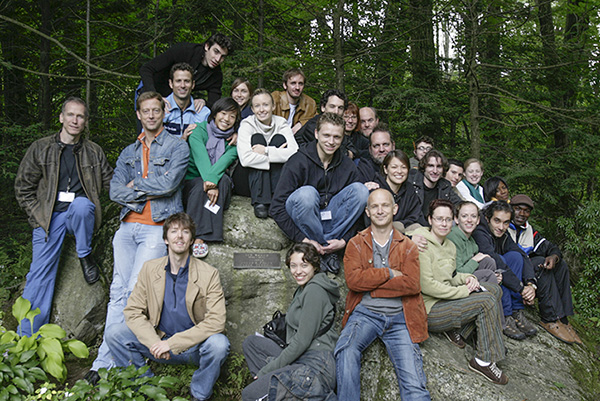
HSDC company photo on the Pillow Rock at Jacob’s Pillow Dance Festival, Becket, MA. Summer 2007. Alejandro (top) and Anne (bottom right, fourth person from the right)
Photo Credit: Cheryl Mann Photography
Hubbard Street is performing a piece created by choreographer Alejandro Cerrudo, entitled One Thousand Pieces, inspired by Marc Chagall’s America Windows. This work is the first evening-length piece they’ve ever performed. How do you see performing an evening-length piece as different from the vignettes they usually perform?
Well, as I alluded to before, the company is very much known for their repertory performances, so this is a really big step. With a repertory performance, you’re seeing work by lots of different choreographers, the pieces will be different, although you still try to program with something that brings the evening together or gives an arc to the performance as a whole. When you have a full-evening work, you’re still going to get some variety, but the performance will usually have just one central theme or look to it.
Has this been several years in the making?
Yes, they’ve been working towards this for a long time. I was with the company for 15 years and I think from my second or third year, they started talking about at some point doing a full evening work. There were many different choreographers discussed for doing a full evening work, and I’m so proud of the company for taking the big leap with Alejandro.
Not only is it the first evening-length work for Hubbard, but this was Alejandro’s first full evening work as well. Selecting such a young, up and coming choreographer really speaks to the core of what Hubbard Street is about: nurturing talented, young artists and helping them explore their talents.
Mr. Cerrudo was a dancer with the company before he became Hubbard’s first Resident Choreographer, yes?
Correct – he joined the company as a dancer in 2005 from NDT2 in Holland, although he is originally from Spain. NDT2 is legendary in its ability to identify and support the work of emerging professional choreographers. Alejandro participated in the choreographic workshops there and then at Hubbard, once he started dancing with us.
The first year Alejandro participated in the choreographic workshop, he did this amazing, beautiful duet, and Jim Vincent, artistic director at the time, asked him to create a full piece that grew out of that duet, which was later to become Lickity Split. And then, every year, Alejandro created a piece in that choreographic workshop which usually in one form or another became part of the Hubbard Street rep. In 2008, he became a choreographic fellow at Hubbard, and the following year, became Hubbard’s first resident choreographer. He’s done many works now for Hubbard as well as being hired by other companies to create for them.
Because he was a dancer with the company, he has gotten to know the Hubbard Street dancers in a way he does not know dancers from the other companies. The intimacy he was able to create in One Thousand Pieces because of that really comes across.
How do you think Chagall’s widely-known America Windows will function within the choreography of One Thousand Pieces?
Well, I’ve talked to Alejandro about it, and I was actually able to see the piece last fall when it was performed in Chicago, and I think it’s really important for people to know that the Windows were a point of inspiration.
He’s not recreating the windows or trying to tell a story. What influenced him was the idea of windows, and how windows and reflections off of glass distort, enhance, frame.
Also too he’s added some technical aspects that work with his voice and vision, embracing the technological age he grew up in. At one point in the piece, the dancers dance in water on stage in front of a mist curtain. You get the visual power of that, the smoothness of movement through the water, the sounds of that…it’s really quite unique and special.
Anything else audiences should look out for when seeing One Thousand Pieces?
I would encourage audience members to look for the duets, trios, and other small groupings of the company. I still harken back to the talent Alejandro displayed in choreographing the duet in his first workshop at Hubbard Street. He creates stunning duets, especially using his knowledge of the dancers on a personal level, having performed with them before, to his advantage. The group stuff is also very beautiful, but there’s something extraordinary about his small groupings.
I hope too that audiences will remain open-minded to a full evening, single-choreographer work from Hubbard Street. There’s music they’ll recognize, Philip Glass, and it’s a moment to enjoy the beauty of bodies, lighting, and music. Take away from it your own experience. Alejandro would say himself the piece doesn’t have to mean the same thing to him that it means to you. That’s not what it’s about. It’s about sharing that moment of beauty and letting it be whatever it is to you.
Thanks, Anne!
For more information on Hubbard Street performing at UMS this fall, see their artist page [here].
UMS Book Club with Nicola’s Books
New this season, UMS is kicking off UMS Book Club. UMS and Nicola’s Books have teamed up to assemble a list of fiction, poetry, and non-fiction, matching six performances with books that carry similar themes, messages, or character traits. Get reading and dig deep into elements of the performance.
Here’s how to join
Pick up a book from the UMS Book Club list at Nicola’s Books (at a special discount of 15%) and unlock a special offer of up to 25% off to the related performances. Nicola’s Books is located at 2513 Jackson Avenue, Westgate Shopping Center, Ann Arbor, MI 48103.
You can use the code online at ums.org. You can also call our UMS Ticket Office at 734.764.2538 or visit the Michigan League Ticket Office. Be sure to mention the the promo code at the start of your order.
This offer is not valid on previously purchased tickets, in conjunction with any other offer, or at the door on the evening of the performance.
The books
 Book: Seven Japanese Tales by Jun’ichirō Tanizaki
Book: Seven Japanese Tales by Jun’ichirō Tanizaki
Performance: Complicite: Shun-kin, September 18-21, 2013 at Power Center
Inspired by the work of one of the most important Japanese writers of the 20th century, Jun’ichirō Tanizaki, Shun-kin tells a tale of devotion, passion, and power, where beauty is unforgiving and love is blinding.
 Book: The Age of Miracles by Karen Thompson Walker
Book: The Age of Miracles by Karen Thompson Walker
Performance: Ballet Preljocaj, November 1-2, 2013 at Power Center
And Then, One Thousand Years of Peace, which will be seen only at UMS, BAM, and Minneapolis, was first created by Angelin Preljocaj for the Bolshoi Ballet in 2010 and takes inspiration from the vision of apocalypse conjured by St. John in the biblical Book of Revelation. Karen Thompson Walker’s acclaimed novel is about a quieter apocalypse, when the Earth’s rotation slows, is a coming-of-age tale that clings to hope in light of a collapsing world.
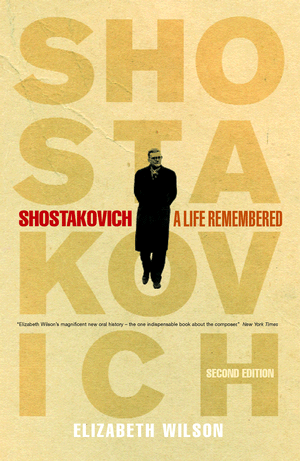 Book: Shostakovich: A Life Remembered by Elizabeth Wilson
Book: Shostakovich: A Life Remembered by Elizabeth Wilson
Performance: Kremerata Baltica, February 6, 2014 at Hill Auditorium
Kremerata Baltika will perform Shostakovich’s Anti-formalist Gallery, a dangerously satirical cantata never intended to be published or performed, as it would have imperiled his safety. In her biography of the composer, Elizabeth Wilson covers the discrepancies between Shostakovich’s public image and private life “from his early successes to his struggles under the Stalinist regime, and his international recognition as one of the leading composers of the twentieth century” through the reminiscences of his contemporaries and his personal writings.

Performance: Théâtre des Bouffes du Nord: The Suit, February 19-22, 2014 at Power Center
Peter Brook’s tender production makes Can Themba’s tightly crafted, unsettling fable sing. African melodies and Schubert lieder thicken the air of this apartheid-era summer in which a shared wound is not allowed to heal. This collection of stories from the African continent, presenting many different visions of Africa and reflecting on the continent’s tragic, imperialized history, includes Can Themba’s fable.
 Book: Tropicana Nights: The Life and Times of the Legendary Cuban Nightclub Paperback by Rosa Lowinge
Book: Tropicana Nights: The Life and Times of the Legendary Cuban Nightclub Paperback by Rosa Lowinge
Performance: Alfredo Rodríguez Trio and Pedrito Martinez Group, March 14, 2014 at Michigan Theater
This double-bill performance features percussionist and vocalist Pedrito Martinez, who incorporates the folklore of his Cuban roots with religious Yoruba chants and batá melodies into the traditional clave beat of popular Latin jazz, and Cuban-born Alfredo Rodríguez, a young pianist of astonishing virtuosity and imagination, performs with the open spirit of a culture rooted in dancing. These musicians represent a new generation of Cuban-influenced music, while Rosa Lowinge’s Tropicana Nights is a window into the culture and history of pre-Revolutionary Cuba through Havana’s notorious Tropicana nightclub, an estate frequented by legends like Nat “King” Cole, Liberace, Josephine Baker, and Ernest Hemingway.
 Book: The Essential Rumi
Book: The Essential Rumi
Performance: Asif Ali Khan Qawwali Music of Pakistan, March 21, 2014 at Rackham Auditorium
If the late, great Nusrat Fateh Ali Khan (1948-97) was known as “the emperor of Qawwali,” Asif Ali Khan — who was once hailed by the maestro as one of his best students — has surely emerged as the music’s reigning prince. Asif is a superstar in his native Pakistan and a powerful figure on the international stage, remaining faithful to the sublime traditions of devotional Sufi music. Rumi is perhaps the most well-known exponent of Sufi poetry; both spiritual and carefully crafted, these poems aim to reveal the human soul.
Did you read one of these books and attend the related performance? Share your thoughts or questions in the comments below.


